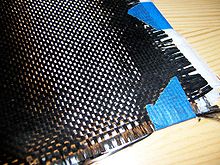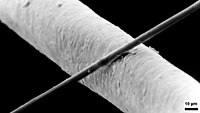Carbon fibers: Difference between revisions
m Reverted edits by 86.139.16.42 to last version by Deli nk (HG) |
|||
| Line 5: | Line 5: | ||
<!-- Please do not change the spelling of color to colour. Wikipedia policy is to retain the English dialect used in the first nonstub version of an article. This prevents needless "spelling wars". Changing the spelling also breaks links and categories. Changing the spelling will be treated as vandalism, and for this reason will be swiftly reverted. Please see the discussion page if you want to comment. --> |
<!-- Please do not change the spelling of color to colour. Wikipedia policy is to retain the English dialect used in the first nonstub version of an article. This prevents needless "spelling wars". Changing the spelling also breaks links and categories. Changing the spelling will be treated as vandalism, and for this reason will be swiftly reverted. Please see the discussion page if you want to comment. --> |
||
'''Carbon fiber''' or '''carbon fibre'''<ref>See [[American and British English spelling differences#-our, -or|American and British English spelling differences]].</ref> (alternately called '''[[graphite]] fiber''' or '''graphite fibre''') is a material consisting of extremely thin fibers about 0.0002–0.0004 inches (0.005–0.010 mm) in diameter and composed mostly of carbon atoms. The carbon atoms are bonded together in microscopic crystals that are more or less aligned parallel to the long axis of the fiber. The crystal alignment makes the fiber incredibly strong for its size. Several thousand carbon fibers are twisted together to form a yarn, which may be used by itself or woven into a fabric.<ref name="answers">[http://www.answers.com/topic/carbon-fiber?cat=technology carbon fiber: Definition and Much More from Answers.com<!-- Bot generated title -->]</ref> Carbon fiber can be combined with a [[Plastic|plastic resin]] and wound or molded to form [[composite material]]s such as [[carbon fiber reinforced plastic]] (also referenced as carbon fiber) to provide a high strength-to-weight ratio material. The density of carbon fiber is also considerably lower than the density of steel, making it ideal for applications requiring low weight.<ref> Mr. Jeremy Hierholzer, Assistant Professor of Aviation Technology, Purdue University, 2007.</ref> The properties of carbon fiber such as high tensile strength, low weight, and low thermal expansion make it very popular in aerospace, military, and motorsports, along with other competition sports. |
'''Carbon fiber''' or '''carbon fibre'''<ref>See [[American and British English spelling differences#-our, -or|American and British English spelling differences]].</ref> (alternately called '''[[graphite]] fiber''' or '''graphite fibre''') is a material consisting of extremely thin fibers about 0.0002–0.0004 inches (0.005–0.010 mm) in diameter and composed mostly of carbon atoms. The carbon atoms are bonded together in microscopic crystals that are more or less aligned parallel to the long axis of the fiber. The crystal alignment makes the fiber incredibly strong for its size. Several thousand carbon fibers are twisted together to form a yarn, which may be used by itself or woven into a fabric.<ref name="answers">[http://www.answers.com/topic/carbon-fiber?cat=technology carbon fiber: Definition and Much More from Answers.com<!-- Bot generated title -->]</ref> Carbon fiber can be combined with a [[Plastic|plastic resin]] and wound or molded to form [[composite material]]s such as [[carbon fiber reinforced plastic]] (also referenced as carbon fiber) to provide a high strength-to-weight ratio material. The density of carbon fiber is also considerably lower than the density of steel, making it ideal for applications requiring low weight.<ref> Mr. Jeremy Hierholzer, Assistant Professor of Aviation Technology, Purdue University, 2007.</ref> The properties of carbon fiber such as high tensile strength, low weight, and low thermal expansion make it very popular in aerospace, military, and motorsports, along with other competition sports. |
||
==History of Carbon Fiber== |
|||
In 1957, Dr. Roger Bacon created the first high-performance carbon fibers at the [[Union Carbide]] Parma Technical Center, located outside of [[Cleveland]], [[Ohio|Ohio]].<ref>[http://acswebcontent.acs.org/landmarks/landmarks/carbon/car3.html Bacon’s breakthrough<!-- Bot generated title -->]</ref>The first fibers were manufactured by heating strands of [[rayon]] until they carbonized. This process proved to be inefficient, as the resulting fibers contained only about 20% carbon and had low strength and stiffness properties. In the early [[1960s]], a process was developed using [[polyacrylonitrile]] (PAN) as a raw material. This had produced a carbon fiber that contained about 55% carbon and had much better properties. The polyacrylonitrile (PAN) conversion process quickly became the primary method for producing carbon fibers.<ref name="answers"/> |
|||
On [[January 14]], [[1969]] Carr Reinforcements ([[Stockport]], [[England]]) wove the first ever carbon fiber fabric in the world.<ref name="carr">{{cite web|title=Carr Reinforcements|url=http://www.carrreinforcements.com/about.htm|accessdate=2008-06-01}}</ref> |
|||
During the [[1970s]], experimental work to find alternative raw materials led to the introduction of carbon fibers made from a petroleum pitch derived from oil processing. These fibers contained about 85% carbon and had excellent flexural strength.<ref name="answers"/> |
|||
==Structure and properties== |
==Structure and properties== |
||
Revision as of 09:33, 24 September 2008
This article needs additional citations for verification. (April 2007) |

Carbon fiber or carbon fibre[1] (alternately called graphite fiber or graphite fibre) is a material consisting of extremely thin fibers about 0.0002–0.0004 inches (0.005–0.010 mm) in diameter and composed mostly of carbon atoms. The carbon atoms are bonded together in microscopic crystals that are more or less aligned parallel to the long axis of the fiber. The crystal alignment makes the fiber incredibly strong for its size. Several thousand carbon fibers are twisted together to form a yarn, which may be used by itself or woven into a fabric.[2] Carbon fiber can be combined with a plastic resin and wound or molded to form composite materials such as carbon fiber reinforced plastic (also referenced as carbon fiber) to provide a high strength-to-weight ratio material. The density of carbon fiber is also considerably lower than the density of steel, making it ideal for applications requiring low weight.[3] The properties of carbon fiber such as high tensile strength, low weight, and low thermal expansion make it very popular in aerospace, military, and motorsports, along with other competition sports.
Structure and properties

Carbon fibers are the closest to asbestos in a number of properties.[4] Each carbon filament thread is a bundle of many thousand carbon filaments. A single such filament is a thin tube with a diameter of 5–8 micrometers and consists almost exclusively of carbon.
The atomic structure of carbon fiber is similar to that of graphite, consisting of sheets of carbon atoms (graphene sheets) arranged in a regular hexagonal pattern. The difference lies in the way these sheets interlock. Graphite is a crystalline material in which the sheets are stacked parallel to one another in regular fashion. The chemical bonds between the sheets are relatively weak Van der Waals forces, giving graphite its soft and brittle characteristics. Depending upon the precursor to make the fiber, carbon fiber may be turbostratic or graphitic, or have a hybrid structure with both graphitic and turbostratic parts present. In turbostratic carbon fiber the sheets of carbon atoms are haphazardly folded, or crumpled, together. Carbon fibers derived from Polyacrylonitrile (PAN) are turbostratic, whereas carbon fibers derived from mesophase pitch are graphitic after heat treatment at temperatures exceeding 2200 C. Turbostratic carbon fibers tend to have high tensile strength, wheresas heat-treated mesophase-pitch-derived carbon fibers have high Young's modulus and high thermal conductivity.
Applications

Carbon fiber is most notably used to reinforce composite materials, particularly the class of materials known as Carbon fiber or graphite reinforced polymers. Non-polymer materials can also be used as the matrix for carbon fibers. Due to the formation of metal carbides (i.e., water-soluble AlC) and corrosion considerations, carbon has seen limited success in metal matrix composite applications. Reinforced carbon-carbon (RCC) consists of carbon fiber-reinforced graphite, and is used structurally in high-temperature applications. The fiber also finds use in filtration of high-temperature gases, as an electrode with high surface area and impeccable corrosion resistance, and as an anti-static component.
Synthesis
Each carbon filament is made out of long, thin filaments of carbon sometimes transformed to graphite. A common method of making carbon filaments is the oxidation and thermal pyrolysis of polyacrylonitrile (PAN), a polymer based on acrylonitrile used in the creation of synthetic materials. Like all polymers, polyacrylonitrile molecules are long chains, which are aligned in the process of drawing continuous filaments. A common method of manufacture involves heating the PAN to approximately 300 °C in air, which breaks many of the hydrogen bonds and oxidizes the material. The oxidized PAN is then placed into a furnace having an inert atmosphere of a gas such as argon, and heated to approximately 2000 °C, which induces graphitization of the material, changing the molecular bond structure. When heated in the correct conditions, these chains bond side-to-side (ladder polymers), forming narrow graphene sheets which eventually merge to form a single, jelly roll-shaped or round filament. The result is usually 93–95% carbon. Lower-quality fiber can be manufactured using pitch or rayon as the precursor instead of PAN. The carbon can become further enhanced, as high modulus, or high strength carbon, by heat treatment processes. Carbon heated in the range of 1500-2000 °C (carbonization) exhibits the highest tensile strength (820,000 psi or 5,650 MPa or 5,650 N/mm²), while carbon fiber heated from 2500 to 3000 °C (graphitizing) exhibits a higher modulus of elasticity (77,000,000 psi or 531 GPa or 531 kN/mm²).
Textile
There are several categories of carbon fibers: standard modulus (250 GPa), intermediate modulus (300 GPa), and high modulus (> 300 GPa).[5] The tensile strength of different yarn types varies between 2000 and 7000 MPa. A typical density of carbon fiber is 1750 kg/m3.
Precursors for carbon fibers are PAN, rayon and pitch. Carbon fiber filament yarns are used in several processing techniques: the direct uses are for prepregging, filament winding, pultrusion, weaving, braiding etc. Carbon fiber yarn is rated by the linear density (weight per unit length = 1 g/1000 m = tex) or by number of filaments per yarn count, in thousands. For example, 200 tex for 3,000 filaments of carbon fiber is three times as strong as 1,000 carbon fibers but is also three times as heavy. This thread can then be used to weave a carbon fiber filament fabric or cloth. The appearance of this fabric generally depends on the linear density of the yarn and the weave chosen. Some commonly used types of weave are twill, satin and plain.
Manufacturers
PAN aerospace/high end carbon fiber:
- Toray Industries (largest worldwide manufacturer)
- Toho Tenax
- Mitsubishi
- Hexcel
- Cytec Industries
- Schunk Gruppe
PAN commercial grade carbon fiber:
- Zoltek
- SGL Carbon
- Fortafil
Pitch carbon fiber:
See also
Notes
- ^ See American and British English spelling differences.
- ^ carbon fiber: Definition and Much More from Answers.com
- ^ Mr. Jeremy Hierholzer, Assistant Professor of Aviation Technology, Purdue University, 2007.
- ^ Properties And Fiber Types
- ^ "Carbon Fiber Data Sheets - Continuous Fiber", Hexcel Corporation, 26 November 2007.
External links
- Bacon's breakthrough at ACS.org
- Carbon Fiber at ps
- The Chemistry of Carbon Fiber
- Making Carbon Fiber
